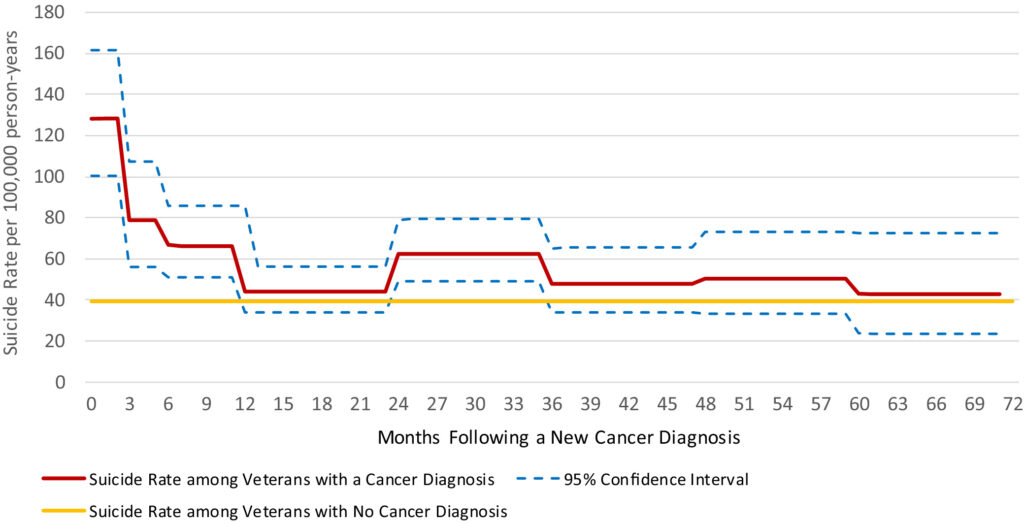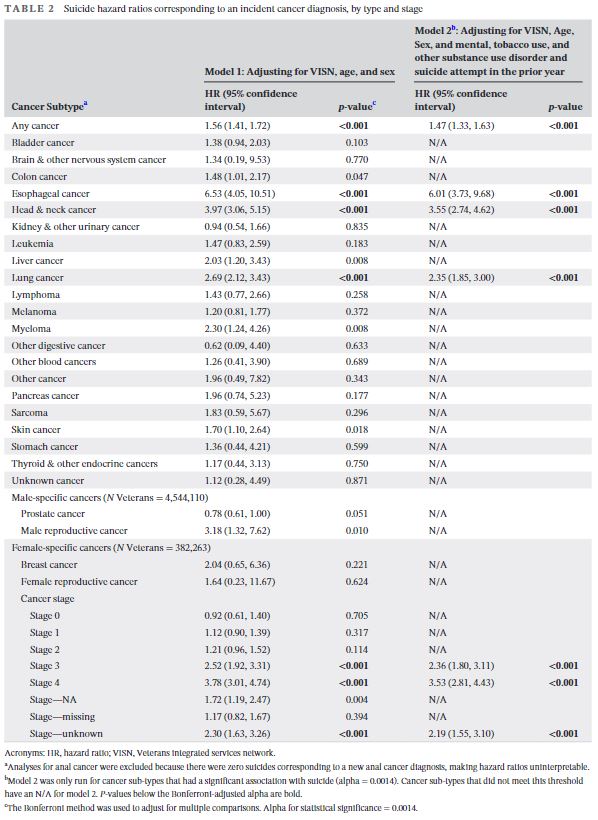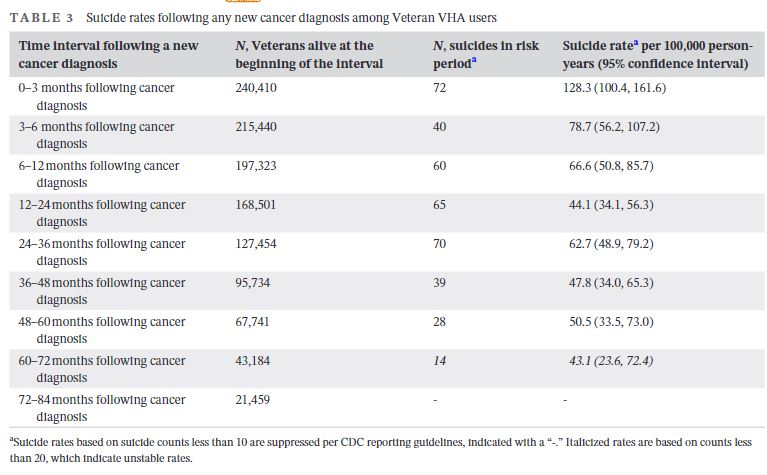ANN ARBOR, MI — Research has shown that a cancer diagnosis is associated with an increased risk of suicide, which might be attributed in part to factors such as interpersonal struggles, hopelessness, physical pain and strain, financial distress and relationship changes. In addition, physiological factors, such as cytokines produced by tumors and glucocorticoids used to treat cancer, may increase depression and anxiety risk.
For veterans, researchers have reasoned, the risk of suicide related to cancer diagnosis might be even greater. Not only does the veteran population have a higher burden of comorbid health conditions, including cancer, but veteran VHA users diagnosed with cancer have an elevated presence of suicide risk factors including PTSD symptoms, suicidal ideation and mental health and substance-use disorders.
For that reason, understanding associations between new cancer diagnoses and suicide risk, overall, and adjusting for mental health disorders is important for enhancing veteran suicide prevention efforts, according to the authors of the new study, which examines these associations and offers insights. The study, published recently in Cancer Medicine,1 was led by researchers from the VA Serious Mental Illness Treatment Resource and Evaluation Center, Office of Mental Health and Suicide Prevention in Ann Arbor, MI, and the VA) National Oncology Program, Specialty Care Services in Washington, DC.
Using records of more than 4.9 million veterans with VHA use in 2011 and no VHA cancer diagnoses that year and who received VHA care in 2012-2013, the researchers assessed suicide risk following incident cancer diagnoses. Risk time was from initial VHA use in 2012-2013 to Dec. 31, 2018, whichever came first. Cox proportional hazards regression models evaluated associations between new cancer diagnoses and suicide risk, adjusting for age, sex, VHA regional network and mental health comorbidities. Suicide rates were calculated among veterans with new cancer diagnoses through 84 months following diagnosis.
The study’s findings document a positive association between a new cancer diagnosis and suicide risk among veterans engaged in VHA care, the authors wrote.
Overall, 240,346 veterans (4.88% of the study sample) received an incident VHA cancer diagnosis in the period 2012-2018.
Esophageal Cancer Highest Risk
A new cancer diagnosis corresponded to a 47% higher suicide risk, the authors found. The cancer subtype associated with the highest suicide risk was esophageal cancer. Other significant subtypes included head and neck and lung cancer.
“There are several factors which may increase suicide risk within these cancer subtypes,” the authors wrote. “First, disruptions to basic functions such as swallowing, talking and breathing may contribute to reduced quality of life, which is associated with higher risk of suicidal behavior in cancer patients. Second, the poor prognosis corresponding to these subtypes likely leads to feelings of hopelessness. Third, due to lung cancer’s associations with well-known, modifiable behaviors there may be a unique component of self-blame which contributes to poorer psychological adjustment and subsequent elevations in suicide risk.”
Cancer subtypes for which cancer was less common among suicide decedents included kidney and other urinary, melanoma, pancreatic and prostate.
Other key findings included:
- Suicide decedents, compared with those who did not die from suicide, were, on average, younger and less likely to be female
- Cancer stages 3 and 4 at diagnosis were positively associated with suicide risk.
- Suicide rates were highest within 3 months following diagnosis and remained elevated in the 3-6- and 6-12-month periods following diagnosis, which was consistent with the literature indicating positive associations between an incident cancer diagnosis and suicide risk among the general U.S. adult population, with risk highest in the months immediately following diagnosis.
- Among suicide decedents during this period, firearms were more likely to be involved. Firearm involvement was most common among those who died by suicide within three months of a new cancer diagnosis (86.3%) and was more common among those who died by suicide more than three months following a cancer diagnosis (81.3%) than those without a VHA-documented cancer diagnosis prior to death by suicide (70.2%). The use of firearms differed significantly across cancer diagnosis groups.
The study’s authors say their findings reinforce the need for VHA oncologists to be aware of and attentive to the mental health needs of their patients. They conclude: “Lethal means safety counseling, routine mental health screening, normalizing discussion about suicide, improving coordination and awareness between patient teams, and engaging cancer patients in mental health treatment may facilitate suicide prevention efforts within VHA oncology.”
- Dent KR, Szymanski BR, Kelley MJ, Katz IR, McCarthy JF. Suicide risk following a new cancer diagnosis among Veterans in Veterans Health Administration care. Cancer Med. 2022 Aug 27. doi: 10.1002/cam4.5146. Epub ahead of print. PMID: 36029038.



